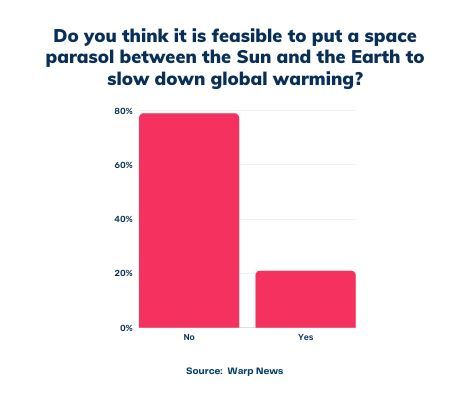
💡 Optimist's Edge: Space parasol to slow global warming
An enormous solar sail between Earth and the Sun could slow Earth's temperature rise enough to give us time to transform into a climate-sustainable society.
Share this story!
The temperature on Earth is rising. Millions of initiatives are underway to tackle the problem, but if that isn't enough, an idea has emerged from astronaut Christer Fuglesang: What if we unfold a gigantic parasol in space to block sun rays and slow down global warming?
📉 What people think
Do people think a space parasol is a feasible solution? Nope! Only 21 percent think so, and 79 percent do not.

📈 Here are the facts
The concept is nearing its twentieth anniversary. Indeed, as early as 2006, Roger Angel, from the University of Arizona, published a seminal paper on the feasibility of cooling earth with “a cloud of small spacecraft”.
Through the years, the concept of space sunshade has evolved and taken lots of different technological shapes.
Today, in 2022, with the ever-growing urgency to tackle heat rise, research has reached certain important conclusions. Astronaut and Professor Christer Fuglesang and Maria Garcia de Herreros Miciano, of the Royal Institute of Technology (KTH) in Stockholm, have evaluated and given clear guidelines as to what such a project could look like.
- Reminding of Bernard Werber’s novel “ The Butterfly of the Stars”, Fuglesang and de Herreros Miciano suggest that using the momentum of photons (light particles) hitting a large enough sail (a thin membrane) would be the best technique to maneuver the spacecraft when in position. They pursue: “there is an excellent synergy between sunshades in space and solar sails. Both need to be large and thin, with a mass per area as small as possible in order to reduce the launch cost from Earth, as well as to increase maneuverability in space.”
According to their calculation, this solar sail should be at least two million square kilometers to have the desired effect. For comparison, this is the size of Mexico. Which could require either manufacturing it or assembling the multiple parts directly in space.
- Confirming Roger Angel’s first proposition, they identify the Lagrange Point 1 (L1) as an ideal location to set the space sunshade. Lagrange points are equilibrium spots where the gravitational and centrifugal forces of two massive objects equate to each other, creating a zone of balance. Aside from pure conceptual questions, related to the heat resistance of the membrane, one important issue resides in bringing such a massive sailcraft to its position. L1 is “only” 1.5 million kilometers from Earth.
Fugelsang and de Herreros Miciano maintain that the best strategy would be to put the sailcraft at the limit of low-earth orbit (around 2000 kilometers), deploy the sail and navigate to L1 for 600 days.
- In terms of costs, they estimate such a sailcraft could be developed for around $50 per kilo. Using SpaceX’s reusable launchers is one of the options to reduce the costs of the operation significantly.
💡 Optimist's Edge
The technical and economic feasibility of a space sunshade is within reach.
“Technological development should start as soon as possible to be able to start launching sunshades to space around 2040", says professor Christer Fuglesang, who is also a Warp Premium Supporter.

“Like any climate effect, the effects will take time to be noticed. To some extent nothing might be observed because the idea is to stabilize the temperature rather than decrease it. To hinder further increase of the average global temperature", says Christer Fuglesang.
👇 How to get the Optimist's Edge
The crucial point is to achieve what is called Technological Readiness Level (TRL). Solar sailing is a new technology that is progressing, but that has never been tested and proven reliable at such a scale.
Actual and small solar-sail projects have reached a score of 7, according to Fuglesang and de Herreros Miciano. Meaning the system prototype demonstrated good signs of functioning in an operational environment.
They estimate that a two million km² solar parasol only obtains a TRL of 3 to 4.
If this project is to launch in 2040, work needs to start now. With either big or small steps, we need to develop it, experiment and perfect it, and then ensure its efficiency.
❓ So, how do you get the most out of this knowledge?
- First, we need to talk about it. And spread knowledge on its potential and feasibility. The more the world hears and knows about it, the greater the potential to make it happen.
- This leads to the second aspect - gathering enough resources and scientific knowledge to build such sailcraft. The Planetary Sunshade Foundation will give you a chance to inform and get to know more and collect donations to support projects.
- If you are a business leader working in the space field, this could be an interesting investment. You could also support research or Ph.D. projects at university, notably to achieve TRL. The target is to improve heat resistance, thinness and minimum mass, and light-reflection capacity.
- The second research field would be to improve launching capacity. With SpaceX's rockets, a solution exists at a relatively low cost, but sending such a massive solar sail remains an extraordinary prowess that would not mind additional help.
- Get in touch with Christer Fuglesang, if you are interested in learning more and helping out.
You now have an advantage because you have gained this knowledge before most others –